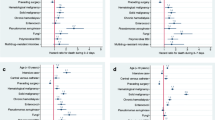Abstract
Purpose
Although bloodstream infection is widely recognized as an important cause of acute morbidity and mortality, long-term mortality outcomes are less well defined. The objective of this study was to define the early (≤28 days) and late (>28 days) mortality and assess determinants of late death following community-onset bloodstream infection.
Methods
All adult residents of the Calgary Zone who had community-onset bloodstream infections during the period 1 January 2003 and 31 December 2007 were included. The mortality outcome was assessed through to 31 December 2008.
Results
A total of 4,553 cases were identified, of which 2,105 (46%) were healthcare-associated and 2,448 (54%) were community-acquired. The 28-day, 90-day, and 365-day all-cause case–fatality rates were 561/4,553 (12%), 780/4,553 (17%), and 1,131 (25%), respectively. Within the first 28 days, the median time to death was 4 (interquartile range [IQR] 1–12) days, with 158 (28%) and 212 (38%) of early (≤28-day) deaths occurring by days 1 and 2, respectively. Among survivors to 28 days (n = 3,992), 570 (14%) suffered late 1-year mortality (i.e., death occurred between 29 and 365 days postinception). The most common causes of death in this cohort as listed by the vital statistics data were malignancy in 220 (39%), cardiovascular in 135 (24%), and infection-related in 37 (7%). Older age, higher Charlson score, prolonged initial admission duration, and healthcare-associated and polymicrobial infections were independently associated with late 1-year mortality.
Conclusions
Community-onset bloodstream infection is associated with major early and late mortality.

Similar content being viewed by others
References
Bearman GM, Wenzel RP. Bacteremias: a leading cause of death. Arch Med Res. 2005;36:646–59. doi:10.1016/j.arcmed.2005.02.005.
Laupland KB, Gregson DB, Flemons WW, Hawkins D, Ross T, Church DL. Burden of community-onset bloodstream infection: a population-based assessment. Epidemiol Infect. 2007;135:1037–42. doi:10.1017/S0950268806007631.
Diekema DJ, Beekmann SE, Chapin KC, Morel KA, Munson E, Doern GV. Epidemiology and outcome of nosocomial and community-onset bloodstream infection. J Clin Microbiol. 2003;41:3655–60.
Mylotte JM, Kahler L, McCann C. Community-acquired bacteremia at a teaching versus a nonteaching hospital: impact of acute severity of illness on 30-day mortality. Am J Infect Control. 2001;29:13–9. doi:10.1067/mic.2001.110567.
Leibovici L, Samra Z, Konigsberger H, Drucker M, Ashkenazi S, Pitlik SD. Long-term survival following bacteremia or fungemia. JAMA. 1995;274:807–12.
Laupland KB, Zygun DA, Doig CJ, Bagshaw SM, Svenson LW, Fick GH. One-year mortality of bloodstream infection-associated sepsis and septic shock among patients presenting to a regional critical care system. Intensive Care Med. 2005;31:213–9. doi:10.1007/s00134-004-2544-6.
Winters BD, Eberlein M, Leung J, Needham DM, Pronovost PJ, Sevransky JE. Long-term mortality and quality of life in sepsis: a systematic review. Crit Care Med. 2010;38:1276–83. doi:10.1097/CCM.0b013e3181d8cc1d.
Vallés J, Rello J, Ochagavía A, Garnacho J, Alcalá MA. Community-acquired bloodstream infection in critically ill adult patients: impact of shock and inappropriate antibiotic therapy on survival. Chest. 2003;123:1615–24.
Shroff GR, Herzog CA, Ma JZ, Collins AJ. Long-term survival of dialysis patients with bacterial endocarditis in the United States. Am J Kidney Dis. 2004;44:1077–82. doi:10.1053/j.ajkd.2004.08.030.
Martínez-Sellés M, Muñoz P, Estevez A, del Castillo R, García-Fernández MA, Rodríguez-Créixems M, et al. Long-term outcome of infective endocarditis in non-intravenous drug users. Mayo Clin Proc. 2008;83:1213–7.
Fätkenheuer G, Preuss M, Salzberger B, Schmeisser N, Cornely OA, Wisplinghoff H, et al. Long-term outcome and quality of care of patients with Staphylococcus aureus bacteremia. Eur J Clin Microbiol Infect Dis. 2004;23:157–62. doi:10.1007/s10096-003-1083-3.
Hanses F, Spaeth C, Ehrenstein BP, Linde HJ, Schölmerich J, Salzberger B. Risk factors associated with long-term prognosis of patients with Staphylococcus aureus bacteremia. Infection. 2010;38:465–70. doi:10.1007/s15010-010-0059-3.
Perl TM, Dvorak L, Hwang T, Wenzel RP. Long-term survival and function after suspected gram-negative sepsis. JAMA 1995;274:338–45.
Gradel KO, Søgaard M, Dethlefsen C, Nielsen H, Schønheyder HC. Magnitude of bacteraemia is a predictor of mortality during 1 year of follow-up. Epidemiol Infect. 2009;137:94–101. doi:10.1017/S0950268808000575.
Schønheyder HC, Søgaard M. Existing data sources for clinical epidemiology: the North Denmark Bacteremia Research Database. Clin Epidemiol. 2010;2:171–8.
Leal J, Gregson DB, Ross T, Flemons WW, Church DL, Laupland KB. Development of a novel electronic surveillance system for monitoring of bloodstream infections. Infect Control Hosp Epidemiol. 2010;31:740–7. doi:10.1086/653207.
Friedman ND, Kaye KS, Stout JE, McGarry SA, Trivette SL, Briggs JP, et al. Health care-associated bloodstream infections in adults: a reason to change the accepted definition of community-acquired infections. Ann Intern Med. 2002;137:791–7.
Quan H, Sundararajan V, Halfon P, Fong A, Burnand B, Luthi JC, et al. Coding algorithms for defining comorbidities in ICD-9-CM and ICD-10 administrative data. Med Care. 2005;43:1130–9.
Karlsson S, Ruokonen E, Varpula T, Ala-Kokko TI, Pettilä V. Long-term outcome and quality-adjusted life years after severe sepsis. Crit Care Med. 2009;37:1268–74. doi:10.1097/CCM.0b013e31819c13ac.
Light TD, Choi KC, Thomsen TA, Skeete DA, Latenser BA, Born JM, et al. Long-term outcomes of patients with necrotizing fasciitis. J Burn Care Res. 2010;31:93–9. doi:10.1097/BCR.0b013e3181cb8cea.
Johnstone J, Eurich DT, Minhas JK, Marrie TJ, Majumdar SR. Impact of the pneumococcal vaccine on long-term morbidity and mortality of adults at high risk for pneumonia. Clin Infect Dis. 2010;51:15–22. doi:10.1086/653114.
Bordon J, Wiemken T, Peyrani P, Paz ML, Gnoni M, Cabral P, et al. Decrease in long-term survival for hospitalized patients with community-acquired pneumonia. Chest. 2010;138:279–83. doi:10.1378/chest.09-2702.
Ranes JL, Gordon SM, Chen P, Fatica C, Hammel J, Gonzales JP, et al. Predictors of long-term mortality in patients with ventilator-associated pneumonia. Am J Med. 2006;119:897.e13–9. doi:10.1016/j.amjmed.2005.12.034.
Million M, Thuny F, Richet H, Raoult D. Long-term outcome of Q fever endocarditis: a 26-year personal survey. Lancet Infect Dis. 2010;10:527–35. doi:10.1016/S1473-3099(10)70135-3.
Kumar A, Safdar N, Kethireddy S, Chateau D. A survival benefit of combination antibiotic therapy for serious infections associated with sepsis and septic shock is contingent only on the risk of death: a meta-analytic/meta-regression study. Crit Care Med. 2010;38:1651–64. doi:10.1097/CCM.0b013e3181e96b91.
Conflict of interest
No external funding was received in support of this study. The authors declare that they have no conflict of interest.
Author information
Authors and Affiliations
Corresponding author
Rights and permissions
About this article
Cite this article
Laupland, K.B., Svenson, L.W., Gregson, D.B. et al. Long-term mortality associated with community-onset bloodstream infection. Infection 39, 405–410 (2011). https://doi.org/10.1007/s15010-011-0149-x
Received:
Accepted:
Published:
Issue Date:
DOI: https://doi.org/10.1007/s15010-011-0149-x




